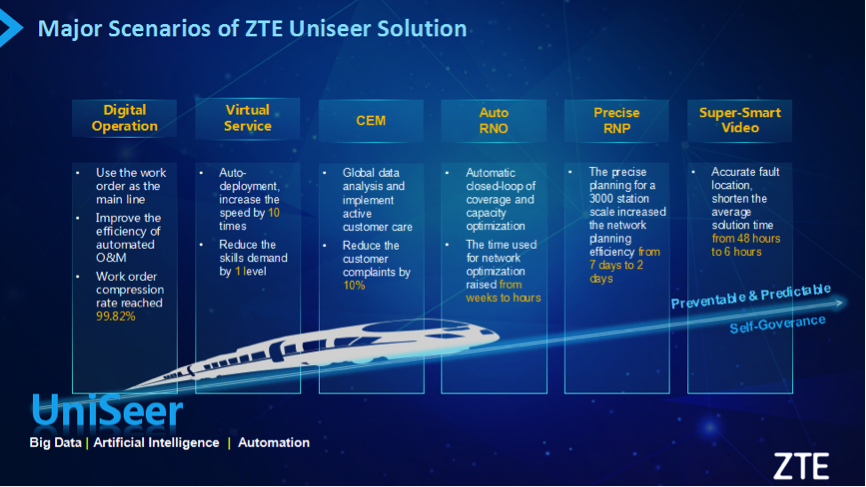With the advent of the 5G era, the network architecture is more open, and the emergence of innovative service applications in vertical industries poses a brand-new challenge to the operation and maintenance of telecom networks. In the conditions that operators’ investment remains steady, how to identify and maximize the value of 5G network construction. Decoupling of software and hardware in the network architecture causes that network construction and deployment involves multiple manufacturers on different layers, which is difficult to be integrated. The telecom market is changing rapidly, requiring fast deployment and commercial use of application services. If multiple networks coexist, how to effectively analyze a large number of cross-domain and cross-layer real-time information to accurately locate and handle faults and improve O&M efficiency.
Automatic and intelligent O&M can be implemented through initiative and prediction, which reduces O&M costs, improves O&M efficiency, focuses on operators and end users’ top experience, thus achieving comprehensive digital service transformation.
ZTE’s UniSeer service solution implements “simplified O&M with excellent experience” through predicting operational status of the network and services, and assists operators in carrying the digital service transformation. This solution has three core capabilities: multiple data warehouses, offline lab, and layered AI engine. The following figure shows the technical structure of UniSeer service solution.

- Multivariate Data Repository: New Energy for Full Automation
UniSeer service solution constructs the multi-data model for the network, based on the big data support platform provides abundant collection means to store the multi-data into the database, and then after data cleaning, governance, association analysis and unified management, provides flexible data service for the upper-level automation and intelligent network applications. Multiple data warehouses decouple service applications from data capabilities, support massive applications, and provide standardized data resources. In addition, data association templates can be configured on demand, quickly solving data structure and standardization problems of different network management systems, manufacturers, regions, and applications, and supporting comprehensive service compatibility. Multiple data warehouses provide efficient and powerful energy for comprehensive automation services, and provide protection, refinement, and re-creation for value data.
- Off-line Lab : Comprehensive Automation Efficiency Engine
For intelligent applications, UniSeer service solution provides offline AI laboratory for modeling, training and verification, and will also support other AI training platforms soon. The model after training is managed in a unified way in the offline lab and provides real-time reasoning services for various intelligent services. For automatic applications, the offline lab provides various policies, configurations, and scripts, and supports other professional tools that have been certified. The offline lab is an operation entity in offline state and consists of three modules:
- Open lab: Continuously develops pre-integration scripts. Online users can complete system integration by executing scripts.
- Cloudstudio APDS: Continuously designs and develops templates for virtualized NEs, sub-slices and slices. Online users can quickly complete network design by invoking the design template and modifying simple parameters.
- AIE: Artificial intelligence development platform. Various AI algorithms are developed continuously. Online users can quickly form intelligent O&M strategies based on algorithms and existing network data, and continuously optimize performance.
- Layered AI Engine: Building Intelligent layered closed loop
UniSeer service solution provides powerful reasoning service for various intelligent services in running state. The AI engine is embedded into the network layer by layer in accordance with the NE level, subnet single-domain level, and cross-domain level to build a layered and closed-loop network intelligentization. The network capabilities are evolved level by level, and the values are continuously superimposed. With the NE-level, the real-time AI engine is introduced to execute AI algorithm models to implement intelligent NE self-loop in scenarios with high real-time requirements. The lightweight smart engine(LSE) is introduced to a single domain of the subnet. It is mainly used in scenarios with low real-time requirements, for example, intelligent shutdown of the base station, to implement a small intelligent subnet ring. The value max smart engine(VSE) is introduced at the cross-domain level in the whole network to implement the intelligent cross-domain network large ring, such as the cross-layer fault prediction and location in the virtualized network. The layered AI engine is modular, lightweight, and embedded at all network levels to meet deployment requirements in various scenarios. Intelligence is gradually implemented. It is implemented from the enhancement of a single professional local function to the extension of a cross-professional scenario. In this way, end-to-end autonomous networks in the entire network can be implemented.
Relying on the research results in the big data and artificial intelligence fields, UniSeer service solution puts forward six major scenarios (sub-solutions), providing operators with intelligent and predictable network planning, deployment, O&M and optimization to reduce O&M costs, improve O&M efficiency, and achieving to simplify O&M and experience.

- Precise planning: Planning as needed with full insight into the future
As the operator’s investment is getting stable, the large-scale site planning and capacity expansion have not completely solved the coverage problems. In addition, we need to consider planning in terms of benefits and values to transform into elaborate investment. ZTE has proposed the precise planning solution, including two key scenarios:
- Benefit enabling scenarios: Explore existing network resources, identify areas that users intend to suppress, and convert network resources into equivalent traffic. In addition to the development of traffic, users’ perception inflection points are predicted and prealarms are given in real time to prevent perception deterioration and user loss. Through this solution, an operator can increase the traffic and benefit, and increase the cell traffic by 8.82% on average.
- 5G planning based on 4G insights: By using 4G network data (high traffic, VIP users, high-end terminals, competition and value scenarios), ZTE can identify valuable areas, establish network construction objectives, and learn about experience gaps and site investment priorities. Through accurate simulation of 3D coverage, capacity, and rate, the solution achieves the objective of new service experience.
- Digital Operation and Maintenance: Do the right thing without the missing task
Digital O&M is a solution of ZTE special for digital transformation, in which it focuses on the information embedded within Work Order (WO), tries to improves operation efficiency for quickly resolving network issues through six core capabilities.
- Fault prediction: Reduces faults and alarms.
- Intelligent RCA and work order suppression: Alarm/work order compression is implemented to improve the work order alarm compression rate.
- Automatic diagnosis and restoration: As work orders are pre-processed, automatic closed-loop of faults is implemented, and front-line work orders are reduced.
- Intelligent scheduling: The front-line processing efficiency is improved through multi-vehicle and multi-professional joint scheduling.
- Work order analysis: Evaluate the automatic efficiency of work orders through automatic work order analysis, and continuously optimize rules.
- Virtualization One-stop Service: Make complicated in a simple way
Virtualization one-stop service solution can provide an efficient package of service solutions from virtual network design, installation and deployment to O&M.
- Virtual network planning and design: The network HLD and LLD lab can output data for 2 hours, greatly improving efficiency. It also supports data validity check, which greatly reduces the data error rate during installation and deployment.
- Virtual network installation and deployment: ZTE AIC tool platform is used to implement zero-intervention, zero-error, end-to-end silence and one-click network agility deployment.
- In a service scenario, the overall network deployment time is reduced from 32 days to 14 days, increasing the efficiency by 65%.
- Virtual network test verification: VIM and VNF tests can be completed within one week, greatly improving test efficiency.
- The virtualized pre-integration function enables unpacking to use. The skill level of onsite personnel can be lowered by one level.
- It implements integrated DevOps from design, deployment to O&M.
- The enhanced capability ensures that three levels alarms are associated based on label matching, locates root faults more quickly, and improves O&M efficiency.
- User Perception Exploration: Aim at excellent experience without direct end-side intervention
The VMAX big data solution can be applied to routine monitoring, which can actively identify unsatisfied users and cells, provide guidance for active optimization, and implement active O&M of “silent” user experience. One-click complaint handling system is used for users who have complained about. The system can trace back and analyze root causes, and can be recovered without dialing to reduce costs and increase efficiency.
The solution has three advantages:
- “Predictability” of User Perception: Users and areas with poor perception can be identified when network indicators are normal and no complaints are generated.
- The impact can be analyzed: Focus on network problems that affect user experience, and analyze the root causes.
- The result can be proved: The delimiting result is verified by radio calibration to reduce the rejection rate of the delimiting result.
- VMAX supports the end-to-end whole-domain perception analysis technology. As an open big data platform, it supports large-scale multi-cluster system and lightweight system. And VMAX supports one-stop intelligent development and data governance of all service streams, provides customized services, and provides value O&M solutions oriented to user perception improvement, user and service development planning.
- AI-driven Coverage and Capacity Optimization: with capabilities of self-learning and value-added improvement
UniSeer intelligent optimization solution obtains historical data such as performance, alarm, configuration and MR through NM and big data platform. Based on AI platform such as AIE and VMAX, it adopts such algorithms as DBSCAN, neural network prediction and genetic optimization for network modeling, performs regional clustering for different service scenarios, implements analysis and prediction such as coverage/capacity and KPI deterioration, and establishes RF fingerprint database and weight database. Through the optimal configuration information of antenna feeder weight parameters can be obtained, it can automatically deliver the information to sites for iterative optimization. In this way, network optimization is automated and intelligent. This solution has the features with fast self-evaluation, efficient self-decision, and precise self-optimization, and can implement precise prediction in advance.
- Super-smart Video: Secure video experience
UniSeer super-smart video solution focuses on user experience and ensures video security, implementing automatic and intelligent O&M. The four highlights of the solution are as follows:
- Fault delimiting and locating in full network: Based on the real service perception, the user experience model is set up to realize active problem discovery and precise locating. As seen in a typical case by such solution, the poor quality rate of live-broadcasting decreased from 0.75% to 0.3%, the rate for excellence of performance for full network increased from 93.8% to 98.8%, resulting in significant improvement of user perception.
- CDN scheduling: The model mark of the indicator system, which outputs AI-based intelligent scheduling policies. CDN scheduling is more accurate, intelligent, and timely.
- Service chain node indicator analysis: Multi-dimensional statistics, rich tables, and node indicator visualization and management.
- Video security: Through advanced kernel monitoring of nodes, it can realize anti-tampering of contents, active prevention in advance, timely alarms in events, and retrospective analysis afterwards.
Aiming at 5G network, ZTE’s UniSeer service solution equips with the functionalities of automaton and intelligence, and supports life cycle related network management with multiple applications for different scenarios of network services. Making complicated in simple way, the solution can predict possible fault in advance, take proactive action for corrective maintenance, and help for increasing better user perception and further improvement of network experience. Definitely, ZTE’s UniSeer is an useful solution for network operator for their digital transformation.

